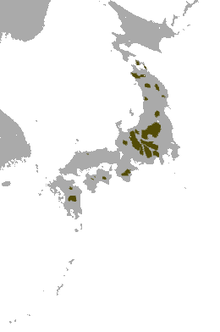True pointed mole rat
| True pointed mole rat | ||||||||||||
|---|---|---|---|---|---|---|---|---|---|---|---|---|

Dymecodon pilirostris |
||||||||||||
| Systematics | ||||||||||||
|
||||||||||||
| Scientific name of the genus | ||||||||||||
| Dymecodon | ||||||||||||
| True , 1886 | ||||||||||||
| Scientific name of the species | ||||||||||||
| Dymecodon pilirostris | ||||||||||||
| True, 1886 |
The true pointed mole ( Dymecodon pilirostris , Syn .: Urotrichus pilirostris ) is a mammal in the mole family (Talpidae) and the only species of the genus Dymecodon, which is monotypical with it . The distribution area is in Japan .
features
The appearance of the true shrews is somewhat similar to the shrews . The snout is very long, narrow and hairy. The species reaches a head-body length of 6.5 to 10 cm and a tail length of 2.5 to 4 cm. Urotrichus talpoides weighs 25 to 40 g and about the same weight is assumed for the true pointed mole rat. Size, relative tail length and coat color vary geographically. The animals of the northern regions of Honshūs are somewhat lighter, smaller and their relative tail length is smaller. In the southernmost range, the animals are darker, larger and the relative tail length is larger. Animals from Nagano Prefecture are in between, the variation of the relative tail length follows everyone's rule . The top of Urotrichus talpoides is black. The northern populations get a little lighter towards the bottom. The southern animals are usually more brownish, their upper side is black-brown. The winter coat is darker than the summer coat. The small auricles are hidden in the fur. The front paws are not as strong as other moles, the claws on the toes are slightly flattened and almost straight. The slightly hairy, relatively long tail (relative length 43% to 60%) has approximately the same diameter over the entire length with the exception of the constricted base and can store fat. The first incisor is about one and a half times the size of the second incisor, very large with a broad tip. The tooth formula is 2-1-4-3 / 1-1-4-3 = 38.
distribution and habitat
The true pointed mole rat is endemic to Japan and is widespread on Honshū including the Kii peninsula , on Shikoku and Kyūshū . This Japanese pointed mole is found in mountain forests, bush and grasslands at higher elevations, usually over 1000 meters.
Way of life
The true pointed mole rat digs underground passages and feeds on earthworms , insects and spiders . Reproduction occurs primarily in spring and, under favorable conditions, can include a second litter in autumn. Females are about four weeks pregnant.
Taxonomy and systematics
Yates (1984) and Yates and Moore (1990) assigned the species formerly belonging to the genus Urotrichus to the genus Dymecodon . The new genus is not recognized by Corbet and Hill (1991) and Hutterer (1993), so the true pointed mole rat is often assigned to Urotrichus . Morphological (Imaizumi, 1970b) and genetic data (Shinohara et al. 2003) support the assignment to a separate genus. The closest relative of the true pointed mole rat is the Japanese pointed mole rat ( Urotrichus talpoides ) , which also lives in Japan . Together both form the tribe of Japanese pointed mole (Urotrichini). The true pointed mole rat lives more underground and can be found mainly in coniferous forests in mountains over 1,000 meters high, whereas the Japanese pointed mole rat is more often found outside of its tunnels and also occurs in the lowlands and in more open terrain.
Danger
The IUCN regards the population of the species as stable and lists the true pointed mole rat as not endangered ( least concern ). The species is common and not exposed to major threats.
Individual evidence
- ↑ Don E. Wilson , DeeAnn M. Reeder (Ed.): Mammal Species of the World . A taxonomic and geographic Reference . 3. Edition. 2 volumes. Johns Hopkins University Press, Baltimore MD 2005, ISBN 0-8018-8221-4 (English, Dymecodon ).
- ↑ a b c d e Ronald M. Nowak: Walker's Mammals of the World. 6th edition. Volume 1. Johns Hopkins University Press, Baltimore MD et al. 1999, ISBN 0-8018-5789-9 , pp. 237-238, Google books .
- ↑ a b c d e Hisashi Abe: Classification and Biology of Japanese Insectivora (Mammalia). In: Journal of the Faculty of Agriculture, Hokkaido University. Vol. 55, No. 3, 1967, ISSN 0020-1804 , pp. 191-265, online (PDF; 5.4 MB) .
- ↑ a b Dymecodon pilirostris in the endangered Red List species the IUCN 2012. Posted by: Abe, H. & Kawada, S., 2008. Accessed January 11, 2013.
- ↑ Dymecodon pilirostris. True, 1886 . In: Don E. Wilson, DeeAnn M. Reeder (Eds.): Mammal Species of the World. A taxonomic and geographic Reference. 3. Edition. 2 volumes. Johns Hopkins University Press, Baltimore MD 2005, ISBN 0-8018-8221-4 .
literature
- Ronald M. Nowak: Walker's Mammals of the World . Johns Hopkins University Press, Baltimore / London 1999.
